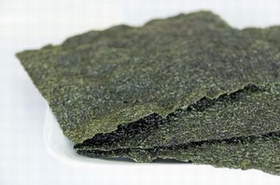 Secretariat of the Pacific Community (SPC), through the European Union-funded Increasing Agricultural Commodity Trade (IACT) Project, has been working with seaweed farming communities in the Pacific to identify new export markets for their products.
Secretariat of the Pacific Community (SPC), through the European Union-funded Increasing Agricultural Commodity Trade (IACT) Project, has been working with seaweed farming communities in the Pacific to identify new export markets for their products.This was one of the key reasons that IACT, in collaboration with the Fisheries, Aquaculture and Marine Ecosystems Division of SPC, assisted seaweed producers and government officers from the fisheries and aquaculture sectors in Fiji, Kiribati, Papua New Guinea and Solomon Islands to take part in the 21st International Seaweed Symposium in Bali, Indonesia.
The symposium, held from 21–26 April 2013, showcased the results of some of the latest research into processed and semi-refined seaweed products that can possibly be used in value-adding opportunities, such as the manufacture of sausages, patties, shampoos, coffee and snacks.
Given that seaweed cultivation is cost-effective and uses low technology, IACT Aquaculture Officer, Avinash Singh, says that there are opportunities in the Pacific for large scale operations in seaweed farming.
"This can be a useful source of income for local communities in isolated outer islands, where few alternative income-generating opportunities exist," he added.
Dried seaweed can be preserved for up to six months, if stored properly. This is important, given that many islands do not have a regular shipping service.
If a critical volume is produced, Singh says that Pacific Islands can look into the possibility of exporting seaweed as a semi-refined powder or in granule form, as this would help reduce shipping costs and increase value.
Alivereti Yaya, from the Agriculture Marketing Authority (AMA), believes that Pacific countries need to learn from Indonesia, which is the world’s biggest dried seaweed exporter, in order to increase their local seaweed production to meet the demands of the market.
AMA – a statutory body of the Fiji Government mandated to assist producers of agro-produce market their products – was one of the participants at the symposium.
Yaya said that AMA had been working with the Fisheries Department in trying to develop this commodity on a bigger scale in Fiji.
Apart from marketing assistance, IACT has also been actively involved in providing technical expertise to farmers, and building external networks to undertake seaweed analysis.
Avinash Singh explained that identifying laboratories that are able to independently carry out seaweed analysis can potentially be used to negotiate better prices and help farmers improve their production.
The symposium was also used by IACT to introduce a new seaweed strain, which is expected to be better adapted to climate change.
The new Maumere strain of Kappaphycus alverzii has been released to the Fiji Fisheries Department holding facilities on Makogai and Kadavu islands for further testing.
Singh said: "We will be assisting with the testing to compare the new strain with the one we now export. If the new strain performs better, it can be passed on to other producer countries in the region."
Solomon Islands is currently the biggest seaweed producer in the South Pacific, with 1,300 tonnes exported last year.





